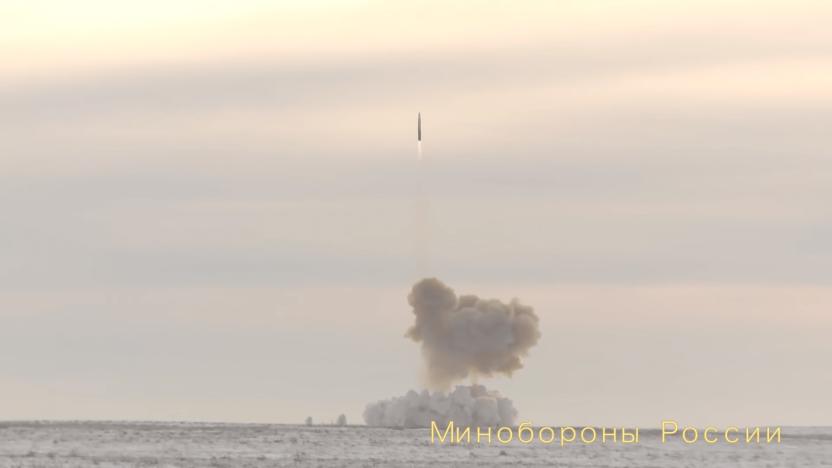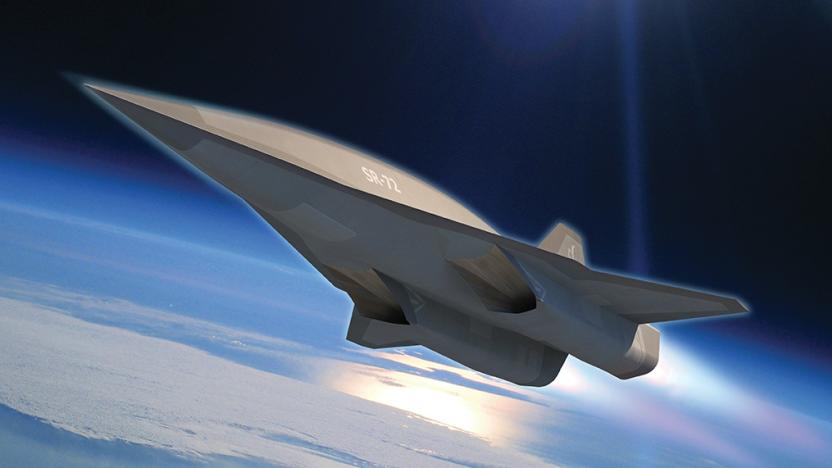hypersonic
Latest

DARPA's hypersonic weapons move closer to free-flight testing
DARPA testing is moving forward on two variants of a weapon concept that can travel faster than the speed of sound.

SpaceX plans seaborne spaceports for Mars missions and hypersonic flights
SpaceX is hiring for planned spaceports that would launch Mars and Moon missions, not to mention hypersonic flights here on Earth.

Russia says its hypersonic missile is now in active service
Russia's vaunted hypersonic missile is now in service -- though to what degree isn't clear. The country's Ministry of Defense has announced that the Avangard system is in use with its first regiment as of the morning of December 27th. The addition theoretically gives Russia the ability to strike targets around the world with relative impunity. The weapon launches like a conventional ballistic missile, but the re-entry vehicle glides into the atmosphere at extreme speeds while staying highly maneuverable at high altitudes -- it could be virtually impossible to stop using existing anti-missile systems.

Russia's hypersonic weapon is reportedly running short on carbon fiber
Russia's plans to build a hypersonic weapon system that can travel at more than 20 times the speed of sound, and also evade US missile defenses, has predictably rattled the world. Last year, Russian President Vladimir Putin boasted that the Avangard weapons system would be ready by 2019. But some obstacles lie ahead that could impact production, CNBC reported. Specifically, the Kremlin needs to find another source of carbon fiber material to build the Avanguard hypersonic glide vehicles.

Russia tested a hypersonic missile it claims will beat all defenses
Russia might have advanced the development of a hypersonic missile system. State-backed media reports that the Defense Ministry has successfully tested Avangard, which mates an ICBM with a glide vehicle that travels up to Mach 5. Officials say they launched the missile from the Orenburg area (near western Kazakhstan) and hit a target thousands of miles away at a test range in Kamchatka. Not surprisingly, the test was conducted on orders from President Putin.

Lockheed's 'Son of Blackbird' spy plane might already be here
The Lockheed Martin SR-71 Blackbird is one of the most recognizable aircraft designs in history. Few other planes have captured the public's attention and imagination in quite the same way as the SR-71 has since it was declassified in 1990 (nearly 30 years after it entered service). And though we're now two decades on from the Blackbird's retirement, America's need for supersonic, high-altitude surveillance has not diminished.

Boeing shows its vision for a hypersonic spy aircraft
Lockheed isn't the only one hoping to make a hypersonic spy aircraft. Boeing has provided early details on its own design for a hypersonic tech demonstrator that would lead to a spiritual successor to the SR-71 Blackbird. In some ways, it's a logical extension of the company's X-51A Waverider: the wedge-shaped, twin-tail body is designed to minimize drag while gulping in as much air as possible. It would be about as long as the Blackbird, but its Mach 5-plus top speed would leave the older Mach 3.2 jet far behind.

China reportedly tests new ballistic weapon that flies under radar
A US government source told The Diplomat this week that China has conducted flight tests of a missile equipped with a hypersonic glide vehicle (HGV). Two tests of the HGV, a model known as the DF-17, took place in November and China is understood to have conducted a number of other tests of experimental HGVs throughout 2014 and 2016. The DF-17 is thought to have a range of between 1,800 and 2,500 kilometers and represents a new kind of weapon system, one that the US and Russia are also developing.

US and Australia finish a key round of hypersonic missile tests
The US and its allies are determined to be first out of the gate with hypersonic weapons, and they've just taken a big stride forward in that regard... not that they're saying much about it. Both the US and Australia have confirmed that they recently completed a series of mysterious hypersonic missile tests. All the countries will say is that the flights were successful, and that they represented "significant milestones" in testing everything from the design assembly to the control mechanisms. They won't even say which vehicles were used or how quickly they traveled, although past tests have usually relied on Terrier Orion rockets (above) and have reached speeds as high as Mach 8.

Hypersonic aircraft are more realistic thanks to a ceramic coating
There are a few reasons why you aren't flying across the country in hypersonic aircraft, but the simplest of them is heat: when you travel at speeds over Mach 5, the ultra-high temperatures (around 3,600F to 5,400F) strip layers from metal. How do you protect a vehicle when even the toughest ceramic tiles can't handle those conditions? A team of British and Chinese researchers might have the answer. They've engineered a carbide-based ceramic coating that's about 12 times more effective than current ceramics, making hypersonic aircraft more realistic.

ICYMI: Hypersonic plane, social connections app and more
#fivemin-widget-blogsmith-image-184810{display:none;} .cke_show_borders #fivemin-widget-blogsmith-image-184810, #postcontentcontainer #fivemin-widget-blogsmith-image-184810{width:570px;display:block;} try{document.getElementById("fivemin-widget-blogsmith-image-184810").style.display="none";}catch(e){} Today on In Case You Missed It: Germany is trying to revive a decades-old plan for a hypersonic commuting plane which would deliver people from Frankfurt to Australia in 90 minutes. A video for a social connection app called Knock Knock stars a couple celebs who will likely never ask to be connected to little ol' me at a party. And a custom drone builder is calling it what it is with a giant eyeball drone. Just to clear up any confusion.

US Air Force and DARPA team up on hypersonic weapons
"What do we want to do with this technology? We want to weaponize it." The US Air Force told Military.com it's planning to build on the X-51A WaveRider's "scramjet" (supersonic ramjet) trials to develop hypersonic weapons that compress air by sheer velocity. During tests in 2013, the WaveRider set a record by flying at Mach 5.1 (3,400mph) for over three minutes after it was dropped from a B-2H bomber and accelerated by a rocket. While those trials were just a proof-of-concept, the Air Force has teamed up with DARPA take the technology to the next level.

The Big Picture: living sculpture made from programmed wooden balls
Let's face it: with certain exceptions, most sculptures are pretty static and won't hold your interest for more than a brief glance. You may pay more notice to Hypersonic's Breaking Wave project, however. Effectively, it's a "programmed" analog display -- an elaborate, centralized motor system pulls 804 wooden balls up and down to create elaborate patterns that you'll only see if you watch from the right perspective. The size of the drums attached to each ball decide just when and how far they move. Breaking Wave's owner, Biogen-IDEC, is using the artwork as a commentary on medical science. It's supposed to show how researchers sift through "billions" of seemingly meaningless data points to create a clearer picture of the human body. It's a one-of-a-kind design, so you sadly can't buy one if you're entranced by the concept. However, you can either check it out in the videos below or swing by Biogen's office in Cambridge, Massachusetts to see it in person.

Final X-51A WaveRider hypersonic mission achieves Mach 5.1, record flight length
With the third X-51A WaveRider failing to reach hypersonic speed due to a fin failure last August, it seemed the United States Air Force would possibly forgo the fourth (and final) run. On the morning of May 1st, however, that last X-51A got its chance to soar, successfully reaching Mach 5.1 during a record 370-second flight. According to the Wright Patterson Air Force base, the aircraft's rocket booster helped it hit Mach 4.8 about 26 seconds after being released from a B-2H at 50K feet, at which point its air-fed scramjet brought it to 60,000 feet while achieving hypersonic flight. The USAF notes that "it was the longest of the four X-51A test flights [230 nautical miles] and the longest air-breathing hypersonic flight" -- surely taking some of the sting out of the $300 million program's previous shortcomings. Past flights aimed to hit Mach six, with the first and second tests only sustaining Mach five. The aircraft made destructive splashdown landing into the Pacific as planned, but data from the whole flight was recorded. The USAF isn't planning a follow-up to the X-51A anytime soon, though the program will likely serve as a reference for future designs. You can dig into the official rundown at the link below.

X-51A WaveRider hypersonic mission doomed by bum missile fin
The latest attempt to go past Mach 5 with the X51A has finished badly again, as a broken fin caused the missile to lose control before its air-breathing "scramjet'" motor could even kick in. It happened just after the booster rocket phase, which accelerates the craft to at least Mach 4, a high enough velocity for the hypersonic scramjet to work. The craft ended up in the Pacific shortly afterwards instead, and this latest affair may end up dunking the entire $300 million program. The Air Force initiative is already short on funding, and the previous two tries were equally dismal failures -- meaning a fourth missile, already built, may end up a museum piece.

DARPA tests advanced hypersonic weapon prototype, makes railgun sweat
The US Army completed testing of its hypersonic weapon yesterday, launching a test projectile across the Pacific Ocean. The glider flies at a lower trajectory than typical missiles, traveling at several times the speed of sound, making it capable of hitting anywhere on this peaceful ball of blue and green within an hour. We saw DARPA's hypersonic aircraft's successful launch earlier this year -- the Falcon HTV-2 (pictured above) managed to hit the dizzying speed of Mach 20 during its tests, before it crashed. Despite recent military funding issues in the US government, hopefully all things hypersonic will get to fly again soon.

DARPA's Falcon HTV-2 hypersonic aircraft launches today, does New York to LA in 12 minutes (update: lost in flight)
All eyes are on Vandenberg Air Force Base in California today, where DARPA's Falcon HTV-2 unmanned aircraft is scheduled to launch into space at hypersonic speeds, as part of a critical test flight. Measuring just 12 feet in length, the HTV-2 maxes out at a speed of about 1300 16,700 miles per hour (Mach 22), theoretically allowing it to jet from New York to Los Angeles in just 12 minutes and to reach anywhere in the world in less than an hour. The main obstacle, however, has been transitioning from theory to practice. During its first test flight back in April, the craft lasted just nine minutes before intentionally crashing, due to technical failures. DARPA still doesn't know what went wrong during that fateful test, though the agency speculates that the Falcon may have simply overheated. This time around, engineers have adjusted plane's center of gravity and angle of descent, in the hopes that their creation will fare better when it launches on the back of a Minotaur IV rocket, later today. If the test proves successful, it may help fuel similarly inter-galactic defense projects that the Pentagon is exploring as a means to combat terrorism and enemy states. We'll have to wait a little longer to find out whether this initiative actually takes off, but in the meantime, head past the break for a demo video from DARPA. Update: Sadly, while the Minotaur IV rocket launch and separation were successful, the Falcon HTV-2 itself was lost nine minutes into its flight this morning just as its predecessor was. DARPA did manage to collect data up until the crash (somewhere in the Pacific Ocean), however, and says that it plans to review it over the coming weeks. Third time's the charm, maybe?

Hybrid rocket / seaweed jet ready to fly in 2050, keep emissions above ozone (video)
What's cooler than jetting from Paris to Tokyo in under three hours? Getting there in a biofuel burning hybrid rocketplane. The recently announced superjet, the Zehst (short for "Zero Emission Hypersonic Transportation"), loopholes around the whole pollution angle by only using its rocket engines in the stratosphere. Below the ozone however, seaweed-biofuel powered jet engines will kick in for some keen, green landings. Don't get too excited though, the EADS won't even have a prototype ready until 2020, and commercial flights aren't expected to follow until the hump of the century. Look on the bright side though, you've still got that airline-approved Galaxy Tab to keep you occupied for the next four decades of long, dark, redeyes. That's almost as cool, right?

NASA budgets $15 million for hypersonic flight
You're probably familiar with supersonic planes like the SR-71 Blackbird pictured above, which managed to fly at over three times the speed of sound, but imagine this: NASA set aside $15 million to develop a hypersonic plane that could exit our atmosphere at speeds between Mach 5 and Mach 20. The US space agency's not expecting to build it quite that cheaply, of course, and it's not holding out hope for a contractor to build the entire plane just yet -- the organization intends to fund some sixteen smaller science and engineering projects (ranging from "how to build a Mach 8+ engine" to "predicting hypersonic fluid dynamics") and letting would-be government contractors pick and choose. Know how to quantify baseline turbulent aeroheating uncertainty in a hypersonic environment? You've got until November 23rd to get your proposal in. Update: As some have pointed out in comments, hypersonic flight isn't unprecedented -- NASA spent eighteen years developing and testing the X-15 space plane starting in 1951, which reached Mach 6.7 using a rocket engine. [Thanks, Gadi]










